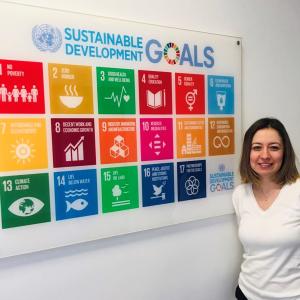Amid ample food supplies, FAO reveals snarls in distribution during COVID-19 pandemic
11 May 2020
- New FAO publication Regional food market situation and policy bulletin in response to the COVID-19 pandemic provides an overview of the export policies of major regional food exporters amid the COVID-19 pandemic, including Kazakhstan, Russian Federation, Ukraine, and the Eurasian Economic Commission.
Budapest, Hungary - In Europe and Central Asia, as well as globally, early indications project near-record wheat production and stock levels in 2020. Food supplies for major food commodities are sufficient. Still, logistics disruptions have emerged as a result of measures to mitigate the COVID-19 pandemic, challenging food distribution and agricultural production in some countries.
All this was revealed in the FAO publication Regional food market situation and policy bulletin in response to the COVID-19 pandemic, which reviews the Europe and Central Asia region.
The report provides an overview of the export policies of major regional food exporters amid the COVID-19 pandemic, including Kazakhstan, Russian Federation, Ukraine, and the Eurasian Economic Commission. It also looks at national policy responses aimed at mitigating the pandemic’s impact on food markets and at ensuring sufficient domestic supplies and food market stability.
The policy brief presents a reassuring assessment of the region’s food markets: They are well supplied with staple foods, and they contain favourable conditions for the production of such staple crops as wheat. At the same time, the publication points out the negative impacts of the ongoing COVID-19 health crisis on transportation, storage, sales, finance, and input availability in the food and agriculture sector.
“We gathered information from countries, often directly from market actors and farmers via questionnaires,” said report author Cheng Fang, FAO economist for Europe and Central Asia. “The fish value chain is the most affected overall, followed by the milk and dairy, livestock, and grains and pulses value chains. The policy brief encourages governments to take corrective action limiting long-standing consequences and gives specific recommendations for that.”
Farmers selling in wet markets, restoration services, farm input suppliers, and transport services have been among the most affected. Food manufacturers also have been running out of space to store their products, and food expiration dates have been a concern. In addition, sales have dropped at both ends of the supply chain, with consumers buying less food and input suppliers seeing price increases on imported items. This can have effects on farmers caught in the middle.
Therefore, FAO advises governments urgently to develop mechanisms to ease cash flow problems that farmers will be facing in the ongoing planting season.
For consumers, the food prices of many agricultural products remained generally stable in countries across the region, such as Kyrgyzstan and the Russian Federation. Prices did increase in some countries, however. In Tajikistan, compared with the same period of the previous year, prices increased by more than 135 percent for fresh onions, nearly 100 percent for potatoes. Prices for cereals, meat and dairy products rose by around 20 percent.
At the international level, prices of wheat – the most significant commodity across the region – have been broadly stable in 2020. However, brisk trade activity and concerns over the COVID-19 pandemic have amplified its price in April in the exporting countries Kazakhstan, Russian Federation, and Ukraine.
“We have seen many smallholders becoming risk averse when planning the planting for the next season; half of the farmers surveyed mentioned problems with the availability of feed, fertilizers and pesticides, too,” Fang added.
To this end, based on the survey results, the following urgent policy actions are recommended: improve health protection and mobility for farmers, food transport operators and food manufacturing industry workers; ensure agricultural input supplies for coming season crops and livestock production by allowing importers access to “green lanes”; assess cold storage capacities; and minimize food loss and the waste through social protection programmes. In addition, the financial stability of farmers should be propped up through new credit guarantee schemes (for operational costs) and agricultural subsidies.
Governments aim to ensure sufficient stocks for domestic consumers and to avoid price increases of staple foods in response to the market shocks and uncertainty caused by the COVID-19 pandemic. Therefore, main exporters in the region – Kazakhstan, Russian Federation and Ukraine – introduced and adjusted export policies on wheat and major food items, while many net agrifood importing countries implemented new policy measures.
“Future policy bulletins are planned to provide communities and governments up-to-date information on the dynamic market situation and policy drivers to support timely and appropriate action aimed at minimizing the impact of COVID-19 on markets and food security,” said Vladimir Rakhmanin, FAO Assistant Director-General and Regional Representative.
The policy brief on food markets and policies – the first of its kind focusing on Europe and Central Asia in the current situation – is available in the English and Russian languages. This edition doesn’t cover European Union policies, instead focusing on 14 selected countries in Eastern Europe, the Caucasus and Central Asia. The coverage of countries and issues will be increased in coming issues of the brief
LINKS:
Europe and Central Asia: Regional food market situation and policy bulletin in response to the COVID-19 pandemic
www.fao.org/documents/card/en/c/ca8869en
Novel Coronavirus (COVID-19)
Q&A: COVID-19 pandemic – impact on food and agriculture
www.fao.org/2019-ncov/q-and-a/impact-on-food-and-agriculture/en/
FAO policy support and governance
www.fao.org/policy-support/coronavirus-pandemic/en/
FAO regional initiative improving agrifood trade and market integration


